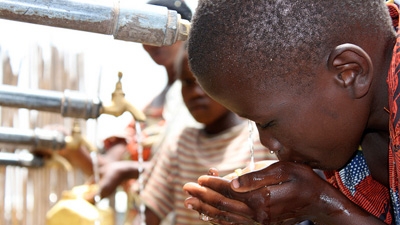Motor-Pumps in Matadi
Located 350 kilometers southwest of Kinshasa, the city of Matadi, the capital of Bas-Congo province, presents a serious challenge for Regideso. Built on a rock, for which it is named (Matadi means "rock" in kikongo), the city's major handicap is the scarcity of natural sources of drinking water. Its only water source is the Congo River. However, in times of extremely low water levels, the Congo River's water level drops dramatically.
Recently, the project coordination team has been increasing the number of trips between Kinshasa and Matadi in a bid to monitor the installation of motor-pumps (pumps that draw water from the Congo River and the M'pozo River into Regideso's facilities, both in the city and the outlying areas). The motor-pumps were purchased on an urgent basis with the agreement of the World Bank.
Last summer, a World Bank mission, led by Madio Fall, the task team leader, had in fact noted that the obsolescence and dilapidated condition of the electromechanical equipment had halved Regideso's production capacity. "It was therefore necessary to resort to using motor-pumps. That was the only solution," Madio Fall states.
Work under the PEMU for the city of Matadi began in November 2012 and will end by June 30, 2014. By 2015, Matadi will have a completely revamped drinking water supply system thanks to the rehabilitation and construction of water production and storage facilities, the rehabilitation of 5,000 household connections, the installation of 10,000 new meters, and the construction of 100 standpipes. Thus, 80 percent of the city's inhabitants would have access to drinking water.
In Kinshasa: Hope is Reborn
Kinshasa, the capital, has approximately 12 million inhabitants. Its population continues to grow and with it, the demand for drinking water. However, demand far outstrips supply. Entire districts lack running water, particularly in the eastern part of the city in the Tshangu district. However, the situation is improving, particularly in a number of districts located west of Kinshasa.
"I've lived in this district for about 10 years, but the water stopped running from my taps around four years ago. My many complaints to Regideso changed nothing," states Hortense Massamba, 50, a resident of the Kintambo municipality in the Nganda district. Twice a week, this mother of six must send her children far from home to obtain water for the house. However, she is a Regideso customer and has a meter.
Yet, Ms. Masamba has noticed that for some time water has been flowing from the tap a little more often. "I check my tap every night before going to bed. It's been two weeks since I’ve been getting water every day although the pressure is weak," she states with a hint of incredulity.
As a result of the PEMU, the kinois consumers’ frustration with Regideso is diminishing. In Kinshasa, the PEMU, which focused in particular on the eastern part of the city, undertook the repair of pumping stations and auxiliary stations. It strengthened the primary pipe network (1,000 mm in diameter) between the Ndjili treatment plant and the airport of the same name, rehabilitated 378 kilometers of the secondary and tertiary distribution networks, and replaced and installed 250,000 meters. In addition, 25,000 new connections to the distribution network were completed and 200 standpipes were installed.
Progress in Lubumbashi
In the copper capital, the drilling campaign is coming to a successful close, particularly in the Luano, UniLu, and Kafubu locations. The PEMU for the city of Lubumbashi aims to provide access to water to close to 85 percent of the population by 2015.
World Bank support is not limited to providing drinking water; the PEMU is also financing technical, financial, and commercial improvements to Regideso. For example, a performance contract has been signed between the State and Regideso.
The issue that remains is access to water from Regideso by people in the country’s other cities. For Madio Fall, the Congolese people should not be too concerned that this project only focused on three cities or three provinces. "The other cities are accounted for in the project's success. Operational capacity building in the target cities, namely Kinshasa, Lubumbashi, and Matadi, will enable Regideso to overhaul its finances in the short term in order to expand rehabilitation of its infrastructure to the other regions of the country, using its own funds. So there will be no cities or population groups left behind," he notes.
Reducing the State's Water Bill
The World Bank requested and obtained the Government's commitment to pay its water bills in full. To date, the Government has made some effort, but is struggling to honor this commitment. To facilitate the authorities' task, the PEMU planned to finance the rehabilitation of water networks for the five highest water consuming administrations, namely the armed forces, the Ministry of the Interior, the Ministry of Health, the Ministry of Justice, and the Ministry of Higher Education.
This component of the PEMU aims to substantially reduce water wastage and, therefore, the State's water bill. The project also includes an educational component, the aim of which is to sensitize the authorities as well as citizens about the need to economize in their water use and to promote behavior change, because without collective awareness, if water flows abundantly, it runs the risk of being wasted.

